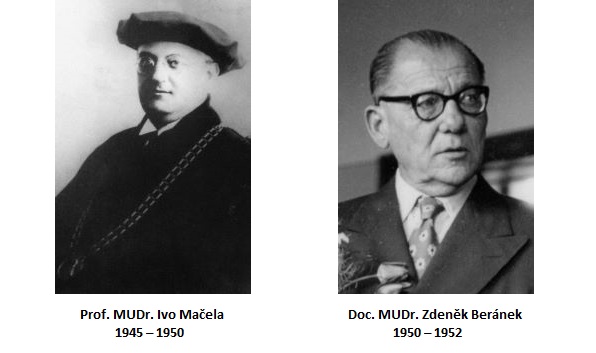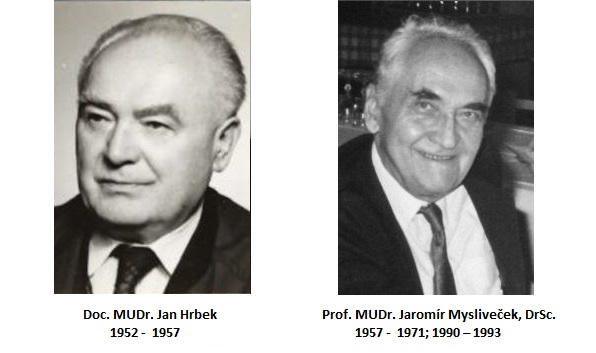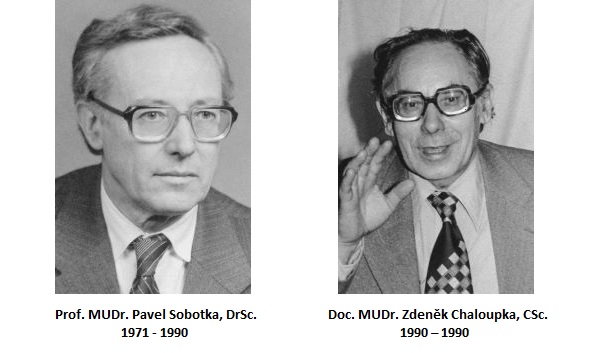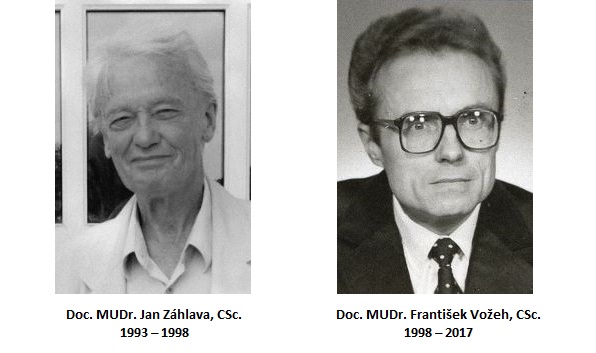The first head of the institute of the newly founded faculty in 1945 was the Dean of it, Prof. Ivo Mačela, M.D., who provided teaching of the discipline Experimental Pathology, only by lectures. After his departure, Assoc. Prof. Zdeněk Beránek, M.D. was a lecturer who travelled to Pilsen from Prague between 1950 – 1952.
In 1952, the name of the workplace was changed to the Institute of Pathological Physiology and its head became Assoc. Prof. Jan Hrbek, M.D. At that time, several young assistants came to the institute and all together they deserved that in addition to lectures also practical exercises were introduced into the teaching process.
The scientific work, initially thematically diverse, then began to be profiled by focusing on the research of higher nervous activity in human. After Prof. Hrbek´s departure to Olomouc Faculty of Medicine, Assoc. Prof. Jaromír Mysliveček, M.D., Ph.D. who came from Prague became a new head of the Institute in 1957. After obtaining DSc. degree, he was then appointed Professor in 1962.
The orientation of the Institute’s scientific focus has remained true to the experimental research of the central nervous system, but with a focus on the ontogenetic development of nerve functions in both norm and pathology.
Nevertheless, it was soon divided into several areas and concerned with:
a) development of functional properties of the nervous system in postnatal ontogenesis,
b) relations between some important development neural centers,
c) higher nervous activity, behavior and their development,
d) monitoring of biochemical correlates of CNS development,
e) influences determining the CNS development and their functional and morphological manifestations.
This complex research, carried out in several animal species, culminated in the late 1960s and was coordinated by Prof. Mysliveček but also his already experienced co-workers.
After the violent interruption of the democratic transformation by the army of “friendly countries” in August 1968, Prof. Mysliveček was deprived of managing the Institute and the Chair, and in 1971 forced to leave the faculty.
After that Assoc. Prof. Pavel Sobotka, M.D., Ph.D. accepted possibility to be a head of the Institute in 1971. When he sucessfully defended doctoral thesis was appointed Professor in 1979. In this politically difficult period of so-called normalization, the staff of the Institute continued their teaching and research activities. For example, a complex of works dealing with the consequences of long-term normotherm complete ischemia of the brain was studied and the issues of experimental epileptogenesis and phenylketonuria (Prof. Sobotka, Eng. Šafanda). Significant progress was made in introducing a microelectrophysiology laboratory in which the bioelectric activity of individual neurons could be registered, and in cooperation with the Oto-rhino-laryngology clinic, a unique (at that time), laboratory for objective audiometry for hearing disorders was developed (Dr. Rokyta). From other clinical workplaces it was further cooperation with Zdenka Ulčová-Gallová, M.D. (today’s professor and DSc.) from the Obstetrics and Gynecology Clinic, in the field of immunology of reproduction. (Eng. Šafanda and Dr. Vožeh). The stereotactic atlas of the brain of the dog during ontogenesis (Dr. Vožeh) was published in the publishing house of the Slovak Academy of Sciences (VEDA Bratislava 1984) in the field of functional brain morphology research, as a monograph. In the mid-1980s, a model of chronic ethanol administration was developed for several generations of laboratory rats and the effects of this addiction on the behavior, electrogenesis and morphology of the brain were studied (Dr. Vožeh). After the “Velvet Revolution”, in 1990, after the tender proceeding Assoc. Prof. Chaloupka, M.D., Ph.D. became the head of the Institute. But in the same year after his death, Prof. Mysliveček returned from Prague and he again became a head of the Institute. His research was then focused mainly on neurotransmitters, namely dopamine and nitric oxide and their role in the development of learning and memory in the earliest ontogenesis. Here, besides other methods, an experimental model of learning on the neuronal level- long-term hippocampal potentiation was used (Dr. Barcal).
In 1993 Assoc. Prof. Jan Záhlava, M.D., Ph.D. became a Head of the Institute.During his leadership the aforementioned research of the institute continued, and new opportunities in foreign relations were used. New professional contacts with renowned workplaces and also long-term stays of Assoc. Prof. Vožeh as a Visiting Professor at the Department of Physiology, University College London (1995, 1996) were realized. In co-operation with dr. K.W.T. Caddy not only interesting findings were published, but also was gained a new experimental model for basic research in neuropathophysiology (Lurcher mutant mice with congenital cerebellar degeneration). At the same time close scientific cooperation with some other countries began. The important timing point was the spring of 1998, when the Institute became the only representative of the Czech Republic in the newly established and internationally coordinated COST program of the EU in neuroscience, Action B10, Brain Damage Repair – and Prof. Vožeh became the only representative of the Czech Republic in the relevant Management Committee. The project of the Institute, entitled “Functional and Morphological consequences of Cerebellar Degeneration and Possibilities of Influencing it”, subsequently received an international grant under this program. In the same year, in autumn 1998, Assoc. Prof. Vožeh became a leader of the Institute and the vast majority of the workplace activities aimed to successfully solve this task. The mentioned research problem, i.e. a study of the cerebellar degeneration in Lurcher mice and other models has become the focal point of the scientific focus of the workplace for the coming years.
At present the centre of research remains focused on cerebellar degeneration in various conditions and during the development. Nowadays, the staff of the Institute has more mouse strains that model this type of neuropathology in humans. With the use of more experimental approaches (behavioural, electrophysiological, histological, histochemical and immunohistochemical methods), not only the pathogenetic mechanisms in various conditions (stress, enriched environment) are studied, but there are also attempts to look for possibilities of influencing them by e.g. neuropharmacs, growth factors, but also by neurotransplantations (embryonic cerebellar tissue or stem cells). Within this research there is a successful long-term cooperation with a number of domestic and foreign workplaces.
The scientific activity of the Institute’s staff is also closely connected with the teaching of pathophysiology, a typically experimental preclinical discipline.
An important milestone for both teaching and research was the autumn of 2014, when the workplace was moved from the Pavlov building to a new object near the Pilsen University Hospital in Lochotín (UNIMEC). The Institute of Pathological Physiology received 2 decent classrooms for teaching (1st for practical manual and surgical exercises and 2nd for seminar forms of teaching), including modern instrumentation. The research tract of the Institute has a complex of modern laboratories (for research on higher nervous and behavioural functions, neurohistological and biochemical, electrophysiological, cell and tissue culture, microsurgery and neurotransplantation).
In addition to pedagogical and research work, the staff of the Institute traditionally participated in the organization of international and national symposia and congresses. The last of these activities was the successful jubilee 20th Conference of Pathological and Clinical Physiology with International Participation, organized by the Institute’s staff in 2015. Teachers of the Institute are also involved in long-term activities of professional societies as members of the Physiological Society, Society of Neuroscience and Society for Pathological and Clinical physiology, at the Czech Medical Society J. E. Purkyně.
Since 2017 Assoc. Prof. Jan Cendelín, Ph.D. became a new head of the institute.
In September 2018 elaborated: Assoc. Prof. František Vožeh, M.D., Ph.D.,
Emeritus Head of the Institute and
Honorary member of the Czech Physiological Society
Heads of the Institute of Pathological Physiology and the time of their leadership since the foundation of the faculty




